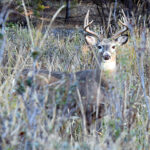Home »

Gardening with ground covers
By Anne Davis
These days, water conservation is a major factor to be considered when landscaping and gardening. Soils dry out fast during hot summer days and even faster when it is windy. One way to spend more time enjoying your garden and less time watering and weeding is to incorporate mulches and ground covers into your landscaping.
Whether you are working with flower beds or removing all or a portion of your lawn, mulches and drought tolerant plants help to keep down the need for watering and weeding. Popular mulch options are shredded bark, wood chips and coloured gravel which help to keep the soil cool, control erosion and discourage weeds. The downside to using bark or wood chips is that the wood leeches nutrients from the soil and breaks down over time, requiring replacement. Another attractive way to cover the ground is to play low-growing, spreading plants also known as ground covers.
While some ground covers are very aggressive – consider them as perennials with a zest for life – some are also well suited to growing in garden beds. You can find ground covers for every need: evergreen or deciduous, flowering or foliage plants and smooth or textured leaves. You can even use them indoors at the base of large houseplants. All you have to do is choose the right plant for the right location.
In the dry, sunny areas of your garden, consider using herbs such as thyme, soapwort or lavender. Soapwort is covered with bright pink blossoms in early summer and spreads to form small colonies by self-seeding. Thyme is so sturdy it can be walked on and it releases a wonderful scent. The tiny leaves and flowers of thyme and lavender smell great and, as an added bonus, are avoided by deer. Other choices include low-growing sedums such as ‘Dragon’s Blood,’ with tiny, reddish purple leaves and bright red flowers, deep magenta flowers of cranesbill geraniums and the grey, velvety leaves of the ‘Silver Carpet’ variety of lamb’s ears (non-flowering). These plants are all drought tolerant once established and provide a range of leaf types, textures and colours. A combination of grey lamb’s ears, pink-edged white dianthus, ‘Max Frei’ cranesbill geraniums, ‘Sarah Bernhardt’ peonies and ‘White Swirl’ Siberian irises make a stunning grey, pink and white grouping.
In shadier areas bugleweed with leather-like leaves, silvery lamium and sweet woodruff with its whorls of tiny leaves can all become rampant unless kept in check. Much better behaved are the glossy leaves of Bergenia, soft, grey-green lady’s mantle and the gorgeous foliage of hostas. Use the purple-leaved bugleweed in a corner of the garden together with astilbe ‘Fanal,’ a variety whose leaves begin as dark purple and change to dark green tipped with purple. Mix in ‘Butter and Sugar’ Siberian iris with its 3’ grass-like leaves and yellow and white blooms, a pink and white columbine and the chartreuse blooms of lady’s mantle and you’ll have three-season colour, texture and interest.
Plant a few groundcovers in your yard this spring. They will reward you with beauty each year, keep your soil moisture in and keep those nasty weed seeds at bay.
 Anne Davis is a writer, blogger, artist and photography buff. Born in Quebec, she now lives in Kimberley, BC where she is editor of and contributor to the City of Kimberley’s Active Community Guide and webmaster for the City’s websites.
Anne Davis is a writer, blogger, artist and photography buff. Born in Quebec, she now lives in Kimberley, BC where she is editor of and contributor to the City of Kimberley’s Active Community Guide and webmaster for the City’s websites.







